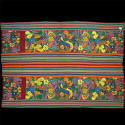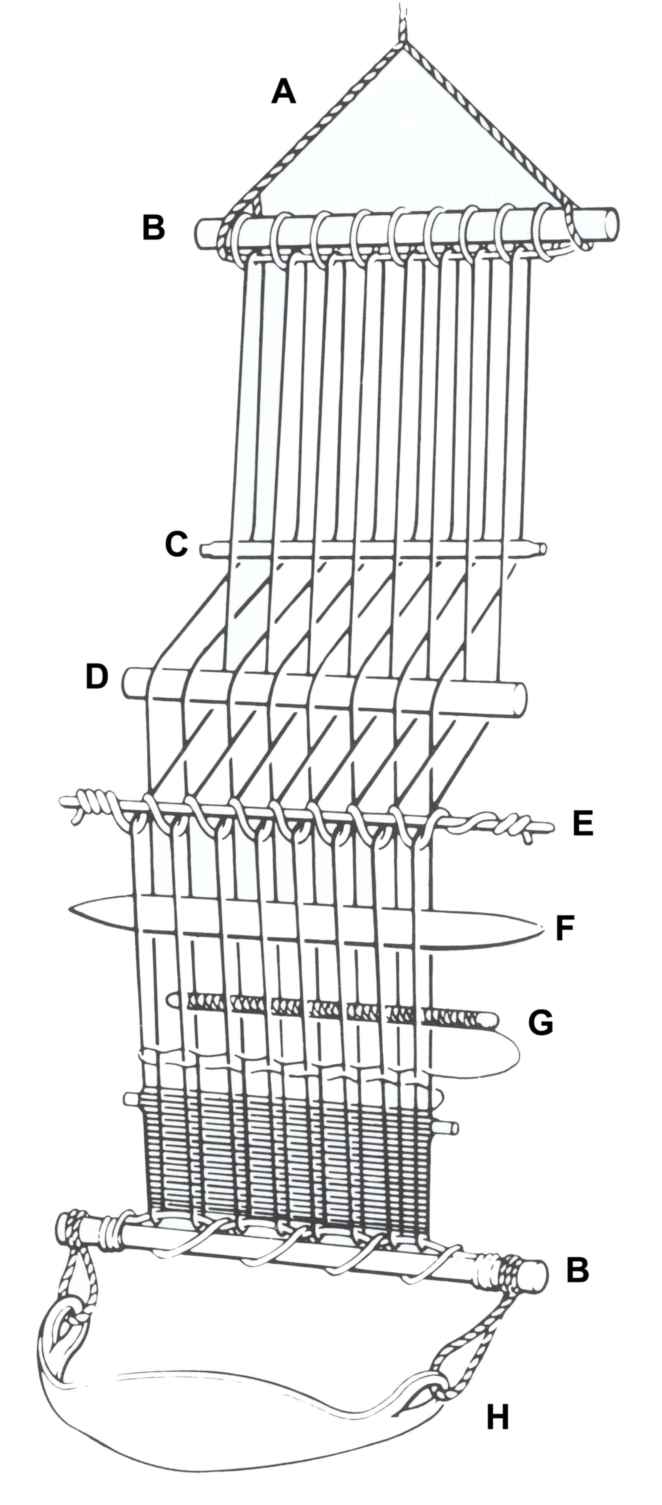|
TEXTILES BOUGHT in GUATEMALA
Fall 2006
(click pictures to
enlarge)
Nim
Po't comments are from their excellent website (www.nimpot.com),
where you can browse by pueblo or by type of clothing. Their website
is very informative, and nicely searches and displays hundreds of items for
sale and items sold with prices. Nim Po't is a large retail store /
museum in Antigua selling new and used textiles, masks and other Guatemalan
crafts.
Also
of great interest, and very well done, are the two textile museums: In
Guatemala City, the Museo Ixchel and in Antigua, Casa del Tejido.
Our friend Linda who works for the Textile Museum in Washington D.C. was
very impressed with the presentation and informative quality of both
museums. Scroll to bottom of page for some
pictures of these museums/stores.
For a
look at the backstrap loom scroll to bottom of this page for
Parts of a
Backstrap Loom used for Mayan Weaving
ANTIQUE
TZUTE (All purpose
cloth.)
  (In
close up, color washed out by flash) (In
close up, color washed out by flash)
Origin: Santa Catarina Ixtahuacan
Description: Predominately reds/rusts,
luscious rich earth tones. Woven geometrics (diamonds). Silk
woven around cotton. Velvety luster. Approx 4’ x 18”
runner. Excellent condition.
Condition: Used. 85 years old
Bought:
Chichicastenango, El Quiche’ – Sunday market; Oct. ’06. From Tienda Tipica
“Antiguedades”
Price: Q850 (asked Q1100) = $113
Nim Po't:
[Not available]
CINTA
(decorative hair ribbon,
wound around the head many, many times; tassels hang free)
 
Origin: Aguacatán, Huehuetenango
Description: 2.8
meters (9 1/4 ft.) long. Red backing. Predominately pink tones with
bright colors. Geometrics (diamonds, zigzags, lines) with metallic thread
and pompom tassels on ends. Excellent condition.
Condition: Used. Approx 12 years old
Bought: Antigua; Nov. ‘06
Price: Q400 (asked Q750) = $53
Nim
Po't: The women's traje
has as it's focus a beautiful single-faced weft-brocaded cinta (hair
ribbon) woven on a backstrap loom on a traditional base of red cotton with
two white warp-edge stripes. It is generally between six and eight feet
long, richly brocaded, and finished with a set of three large tassels at
each end. The motifs employed include stylized bird, plant and human forms,
as well as geometric registers. The brocaded figures in the antique cinta
were sparser, revealing the red base. New cintas in the antique style are
still woven and are generally worn by older women. The newer style features
a dense brocade that virtually covers the base cloth in a cool green and
blue palette, although in the last few years a red-biased warm color scheme
has been emerging [above]. The cinta is first wound around the ponytail,
covering it and taking up most of the cinta's length. The ponytail is then
wrapped halo-like around the head with a section displayed across the top of
the head, protecting the nahual spot. The arrangement of the cinta is
calculated to leave the pompoms hanging beside the ears.
HUIPIL, BLUE w/
BIRDS
  
Origin:
Santiago Atitlán, Lake Atitlán
Description: Blue
medium-weight material with blue/purple trim; embroidered neck and bodice with many types
of birds in detail; neck decorated with green and purple beading
Condition: New
Bought: Santiago
Atitlán, Lake Atitlán; Nov. ‘06
Price: Q500 (asked Q1300) = $67
Nim Po't:
[Not available from Nim Po't. This pueblo is known for their intricate
and realistic bird designs.]
HUIPIL, RED
 
Origin: Patzún, Chimaltenango
Description: Red
lighter-weight material with vertical multicolor stripes, embroidered
flowers around neck/ bodice/ shoulder
Condition: New
Bought: Santiago
Atitlán, Lake Atitlán; Nov. ‘06
Price: Q240 (asked Q400?) = $32
Nim
Po't: Patzún is one of the few highland
towns that prefer hand embroidery to woven brocade. Patzún huipiles are
backstrap loomed in two panels of predominantly red plain weave ground cloth
and supplemented with dense evenly spaced groups of thin warp stripes
bordered with blue and green pinstriped edges. The huipil includes hand
embroidered floral motifs and is popular with women from throughout the
highlands as a more prestigious version of the ubiquitous
machine-embroidered flowered blusa. The design motifs of these garments have
undergone a transformation from embroidered geometric, sun/moon, and feather
figures to the new floral style, an evolution that roughly parallels the
rise in popularity of the machine embroidered blouse. The large ceremonial/
wedding huipil is worn over the wrap-around skirt, in pre-Hispanic style.
Ceremonial huipiles can be identified by the feather motif, often
extravagantly embroidered in silk around the neckline.
HUIPIL, CORAL
  
Origin:
Nahualá
Description: Coral medium-weight material, woven reds/pinks with black and bright
color blocks; geometrics (diamonds)
Condition: Used, 30 yrs old
Bought: Santiago
Atitlán, Lake Atitlán; Nov. ‘06
Price: Q210 (asked Q600) = $28
Nim
Po't: Made of two backstrap-woven panels with four selvedges each, this post-1980 daily use
huipil is in very good overall condition. The materials employed include
rayon, cotton, and embroidery floss. Neck and arm openings are buttonhole
stitched. Traditional motifs include the “woven floor mat” design and
animals composed of diamonds. This piece also reflects the unique to Nahualá
practice of deliberately choosing threads that bleed onto the white base
fabric.
HUIPIL, BROWN
    (underside) (underside)
(In close ups, rich colors washed out by flash)
Origin:
Quetzaltenango (Xela)
Description:
Variegated heavy-weight brown material, woven geometrics/animal in browns/greens/golds/rusts,
with circular “spider” flowers around neck and at shoulders
Condition: ? probably new
Bought:
Santiago Atitlán, Lake Atitlán; Nov. ‘06
Price: Q100 (asked ?) = $13
Nim Po't:
BACKSTRAP WEAVING IN
PROGRESS
complete with wood "frames" and shuttles
  
Actual purchase not
shown. Above, sample of pueblo design (Nim Po't) and backstrap weaving
in progress (La Casa del Tejido)). Scroll down for drawing and
description of a backstrap loom.
Origin: San Antonio Agua Caliente (near Antigua)
Description:
Backstrap weaving in progress, with wood “frame” in place top/bottom and
slide/shuttles (see sketch below). It's about 4 ft. long by 15" wide and will be
displayed as a wall hanging. This pueblo’s technique is considered among the finest, as
the design
is non-geometric and woven (as opposed to embroidery)
Condition: New
(work-in-progress)
Bought: Casa del Tejido (museum &
shop), Antigua
Price: Q1500 (asked Q2100) = $200
Nim
Po't: San Antonio
weavers, who are renowned for the superb quality of their double-faced
marcador technique textiles, use an image drawn on graph paper as a guide to
create their brocaded designs. Since about the 1930s, the
popularity of figurative marcador designs has steadily increased to the
extent that the designs sometimes cover the entire surface of the huipil.
Favorite patterns include realistic flower, bird and cherub motifs, rendered
in vibrant multicolored hues with orange and blue predominating.
Because new San Antonio huipiles are among the most expensive in the
country, they have become a status-symbol trade-huipil when worn by women
from other villages. A square, round or v-shaped neck opening trimmed in
velvet and\or appliqué, usually indicates that the huipil was sold and used
in another village.
PARTS OF A
BACKSTRAP LOOM USED FOR MAYAN WEAVING
 |
A = A cord or rope is used to tie
the loom to a tree or post.
B = End bars are used to hold the warp (vertical threads) to the upper
and lower ends of the loom.
C and D = Shed rods maintain the crossing of the warp's threads.
E = The heddle rod lifts alternate threads of the warp.
F = The batten helps to separate alternate threads of the warp to allow
the bobbin (G) to pass through them. The batten can also be used to
tighten the weft (horizontal threads) as they are woven.
G = The bobbin, containing the thread of the weft, passes from side to
side between the warp.
H = This belt is worn around the weaver's back and connects her to the
loom. The weaver controls the tension on the warp by leaning backward or
forward.Thanks
to www.mayantraditions.com for this exhibit |
THROW
PILLOW COVERS WOVEN USING JASPE TECHNIQUE
  
Condition: New
Bought:
Textura in Antigua (shop with high-quality textiles)
Price:
About Q150 (US$20) each
Description: Jaspe
(called ikat in English), in Spanish meaning speckled or mottled, is
a popular Guatemalan weaving technique, which puts the "white" into the
fabric. Men, using treadle looms, use tie-typed thread to produce
intricate designs as the fabric is woven.
The
process of creating this type of textile is very labor intensive and
time-consuming. Often, whole families are involved in the many steps
required to prepare the yarns for dyeing and Mayan weaving. The first step
involves wrapping a designated number of yarns together tightly with string
at intervals required by a particular pattern.
In preparing a skein of
yarn that is to be used for weft patterns, the skein is stretched between
two sides of a frame made especially for this purpose, and the sections of
the warp that are to remain free of dye are bound tightly with string. In
preparing warps for dyeing, the yarn is stretched between stakes and the
person wrapping it sits on a stool, gradually moving along the length of the
warp as the work progresses. The person doing the knotting for jaspe
patterning must know the position where each tie must be located on the
yarns to be dyed. The wrapping must be done very tightly to prevent seepage,
which would spoil the pattern configuration.
After the yarns are
tightly tied, sometimes with hundreds of wrappings, they are immersed in
dye; when dry, the ties are removed. The areas of the yarns that were
covered by tightly tied string are left free of the dye that has penetrated
the other sections of the yarns. These alternatively dyed and un-dyed areas
form patterns and designs in the textiles woven with them.
Once the jaspe-dyed
yarns are dry, they must be prepared for weaving. Jaspe warps must be
stretched out full length and, with aid of a spreader, carefully arranged,
so the designs are correctly sequenced. The warps are then transferred onto
the warp beam of the loom, where they are precisely aligned to form the
individual patterns, which are interspersed with stripes of plain colored
yarns.
 At
right is an exhibit from the Guatemala City Textile Museum describing this
process. From bottom to top: 1) Natural, un-dyed yarn, or thread
2) Un-dyed yarn tied tightly at exact intervals with string 3) Yarn
dyed, strings still in place 4) Dyed yarn with strings removed
5) Finished product woven with the jaspe technique. At
right is an exhibit from the Guatemala City Textile Museum describing this
process. From bottom to top: 1) Natural, un-dyed yarn, or thread
2) Un-dyed yarn tied tightly at exact intervals with string 3) Yarn
dyed, strings still in place 4) Dyed yarn with strings removed
5) Finished product woven with the jaspe technique.
Jaspe is used a
lot in the traditional skirts, but usually in more subtle colors than our
pillows.
THROW PILLOW
COVERS WOVEN
 
Condition: New
Bought:
Colibri in Antigua (shop with high quality textiles)
Description:
Woven/embroidered covers with zippers.
Price:
About Q180 (US$24) each
|
![]()